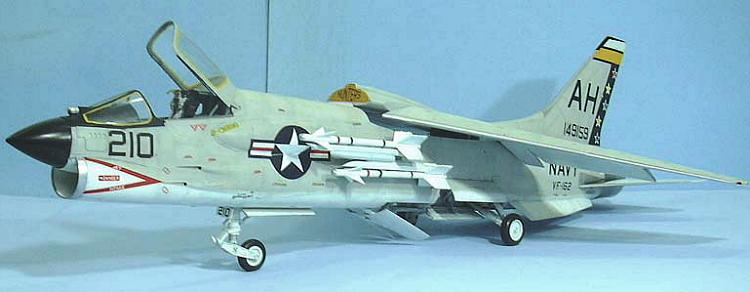
Trumpeter 1/32 F-8E Crusader
| KIT #: | 2272 |
| PRICE: | $159.95 MSRP |
| DECALS: | Two options |
| REVIEWER: | Tom Cleaver |
| NOTES: | AMS Resin seat used |

| HISTORY |
The airplane was lucky from the
beginning. In 1952, as a result of U.S. government legal action, United Aircraft
- of which Vought Aircraft was a component company - was broken up, with Vought
left to fend for itself right after making an expensive move (at government
request) from its original Connecticut factory to Dallas, Texas. Vought had
always been on the cutting edge in the development and production of naval
aircraft, going back to the VE-7, the first U.S. Navy carrier-based airplane.
The F4U Corsair was considered a contender for the title of "best piston-engine
fighter ever built," and was in fact still in production, though the end was in
sight. In any case, the Corsair was "yesterday's technology," and Vought had not
been able to create a successful follow-on design; the F6U "Pirate" being
underpowered and the F7U "Cutlass" being both underpowered and "difficult" to
mate to a carrier. Vought was in need of success if the company was to remain a
viable organization.
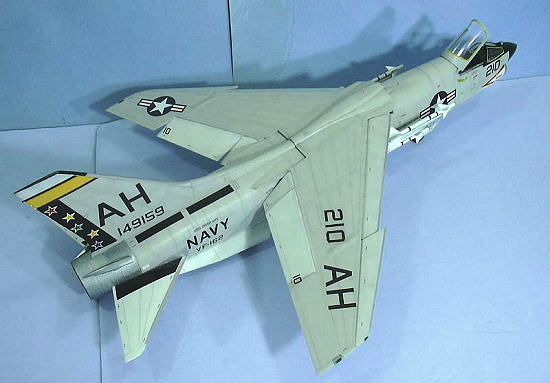 By 1952, the U.S. Navy was well
aware that their current jet fighters were outclassed by the opposition; they
were so desperate to get an airplane that could match the MiG-15 that they went
and bought a navalized version of the MiG-killing F-86 Sabre, which they called
the "Fury." The first generation of what were supposed to be supersonic fighters
- the Douglas F4D "Skyray" and the McDonnell F3H "Demon" - were saddled with the
awful Westinghouse J-40 engine, which didn't deliver the promised power, and for
which Westinghouse seemed unable to find a fix. The Navy needed their next
design to be a "winner," to put the service back in the leading position it had
held with the Grumman Hellcat and Vought Corsair during the Second World War.
By 1952, the U.S. Navy was well
aware that their current jet fighters were outclassed by the opposition; they
were so desperate to get an airplane that could match the MiG-15 that they went
and bought a navalized version of the MiG-killing F-86 Sabre, which they called
the "Fury." The first generation of what were supposed to be supersonic fighters
- the Douglas F4D "Skyray" and the McDonnell F3H "Demon" - were saddled with the
awful Westinghouse J-40 engine, which didn't deliver the promised power, and for
which Westinghouse seemed unable to find a fix. The Navy needed their next
design to be a "winner," to put the service back in the leading position it had
held with the Grumman Hellcat and Vought Corsair during the Second World War.
Vought's submission, which would
become known as the F-8 "Crusader," was lucky from the beginning. Freed of the
requirement to use the dreadful J-40, Vought was able to use the wonderful J-57
- a jet engine that provided high power and great fuel economy. The J-57 had
saved the Skyray, and with a new afterburner was set to power the Air Force's
first fighter capable of supersonic speed in level flight, the F-100 Super
Sabre. Though Vought's design team was creating their airplane prior to Dr.
Richard Whitcomb's publication of The Area Rule, it turned out they had managed
to get "the area rule" so right that the F-8 became the first fully-supersonic
fighter that didn't "look funny" with a "coke-bottle fuselage" or a "wasp
waist," design excrescences which were forced on other designers once the
aerodynamic rules for supersonic flight became known. The result of this would
be that the Crusader, powered by the exact same engine as the F-100, would end
up with greater speed and greater range than its Air Force competitor. The
entire wing other than the folding outer section and the control surfaces, was a
gas tank, while other tanks were provided throughout the long fuselage; it was
also the first supersonic wing to have the needed "dog-tooth" in the design from
the beginning. The wing-body shape of the Crusader was so right that the
airplane ended up a generation ahead of all its competition, world-wide.
Mating a high-performance fighter
like the Crusader to a carrier deck was the big problem, and Vought's solution
was truly elegant: the first variable-incidence wing, which - coupled with
full-span leading edge slats and drooping ailerons - allowed the fuselage to
remain at an angle that provided the pilot with sufficient visibility for a
carrier landing, while not forcing such loads onto the landing gear that would
result in the usual weight escalation for naval aircraft in this area. The
mechanism for operating the wing weighed in at 500 pounds, while the gear was
500 pounds lighter than would have been the case with any other airframe
configuration, which meant the wing was "free." Of the eight designs submitted
to the Navy, the Crusader was the only one which could provide such performance
while still exhibiting the docile flying qualities the Navy needed.
The first XF8U-1 flew on March 25,
1955, powered by the Air Force version of the J-57, the P-11, which provided
less power than the definitive Navy version, the P-12. Even thus "underpowered,"
Vought Chief Test Pilot John Konrad easily took the Crusader supersonic in level
flight - out to Mach 1.2 - on its first flight. Further tests demonstrated that
in comparison with the F-100, the Crusader had longer range, faster climb, more
rapid rate of roll, a smaller turning circle at all speeds and heights, as well
as lower landing speed and a shorter landing run. In fact, de-navalizin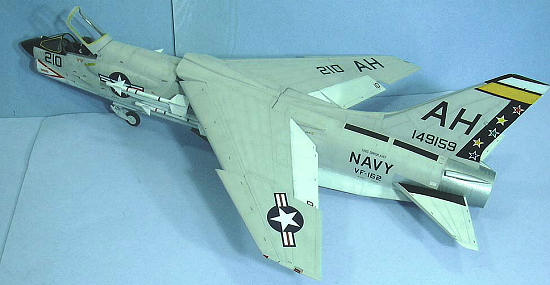 g
the Crusader would have resulted in a world-beating land-based fighter. So few
changes were found necessary that the third Crusader delivered was the first
full-production aircraft - the only visible change being the addition of a
flight refuelling probe on the left side of the forward fuselage, resulting in a
"bulge" that actually added to aerodynamic smoothness.
Outside of that, the other major change was putting in
the necessary wiring to allow the Crusader to use the Sidewinder missile from
the outset.
g
the Crusader would have resulted in a world-beating land-based fighter. So few
changes were found necessary that the third Crusader delivered was the first
full-production aircraft - the only visible change being the addition of a
flight refuelling probe on the left side of the forward fuselage, resulting in a
"bulge" that actually added to aerodynamic smoothness.
Outside of that, the other major change was putting in
the necessary wiring to allow the Crusader to use the Sidewinder missile from
the outset.
On August 31, 1956, CDR R.W. "Duke"
Windsor took one of the first production F8U-1s up to 36,000 feet over China
Lake, California, pushed the throttle forward as he entered a 15-kilometer
course, and set a national speed record of 1,015 m.p.h. - the first time a
non-experimental airplane had flown this fast - an achievement for which he was
awarded the 1956 Thompson Trophy. In April 1956, the Crusader made its first
carrier landing aboard the U.S.S. "Forrestal,"
followed within six months by successful operation from a 27-C conversion of the
World War II-era "Oriskany" carrier.
On July 16, 1957, the Crusader
burst onto the newspaper front pages when an F8U-1P was flown from Los Angeles
to New York in 3 hours, 23 minutes, 8.4 seconds, for an average transcontinental
speed of 726 m.p.h., or Mach 1.1. In fact, the Crusader, which had to come down
from 35,000 feet to 25,000 feet and slow down to 320 m.p.h. to refuel three
times from AJ-2 Savage tankers, was actually flying in full afterburner at Mach
1.7 for the majority of the mission. The Marine aviator who won the
Distinguished Flying Cross for this feat would become far better known when LCOL
John H. Glenn Jr. became the first American to fly in orbit in February 1962.
Like almost everyone who ever flew a Crusader, former Senator Glenn has been
quoted as saying the Crusader was the best airplane he ever flew. Vought topped
a winning year that December when they won the Collier Trophy for having
designed the Crusader.
318 F8U-1s and 144 F8U-1Ps were
followed by 130 F8U-1Es, which had full all-weather capability with addition of
the APS-67 radar. The 187 F8U-2s received the more powerful J57-P-16 engine,
which required the addition of two ram air intakes in the extreme rear fuselage
to cool the hot afterburner, as well as ventral fins for supersonic stability.
The fastest of all Crusaders were the 152 F8U-2Ns, which appeared in 1960 with a
new APQ-83 radar and the J57-P-20 engine, which provided a level speed of 1,230
m.p.h. The 296 F8U-2NEs, which were equipped with a new APQ-94 radar which
required a slightly-large nose, and an IR-seeker, took Crusader production over
1,000 aircraft. Introduced as the F-8E following the 1962 change in aircraft
designations, its heavier weight gave it a speed of only 987 m.p.h., but it also
had ground-attack capability built in, the first Crusader to become a
"mud-mover."
Vought also built 42 F-8E(FN)
Crusaders for the French Navy, the last new-build Crusaders. Already though in
1962, Vought had been involved in remanufacturing the original F8U-1 (F-8A)
aircraft, an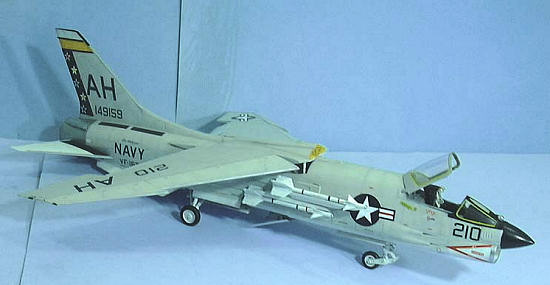 d
this updating process would provide the F-8H (rebuilt F8U-2N/F-8D), F-8J
(rebuilt F-8E), F-8K (F8U-1N/F-8B) and F-8L (F8U-2/F-8C), the latter two were
used as advanced trainers and by a number of USN/USMC Reserve squadrons as well
as by several Composite squadrons. The F-8H - which was only slightly slower in
its rebuilt version than the F8U-2N - was the first re-built Crusader to go to
war in 1967, and was the leading MiG-killer in Vietnam, with more than twice as
many kills as the F-4 Phantom.
d
this updating process would provide the F-8H (rebuilt F8U-2N/F-8D), F-8J
(rebuilt F-8E), F-8K (F8U-1N/F-8B) and F-8L (F8U-2/F-8C), the latter two were
used as advanced trainers and by a number of USN/USMC Reserve squadrons as well
as by several Composite squadrons. The F-8H - which was only slightly slower in
its rebuilt version than the F8U-2N - was the first re-built Crusader to go to
war in 1967, and was the leading MiG-killer in Vietnam, with more than twice as
many kills as the F-4 Phantom.
During the Vietnam war, 42 Navy
F-8s and 20 RF-8s, and 12 Marine RF-8s, were lost to flak and small arms fire.
10 Navy Crusaders were shot down by SAMs, while all 20 of the RF-8's from VFP-63
and all twelve of the RF-8's from VMCJ-1 lost in action were downed by flak or
by SAMs, with none lost to MiGs. At least three Navy Crusaders were lost to MiGs,
all of them being the F-8E fighter version.
The Crusader earned its nickname “MiG-Master”
in air-to-air combat against North Vietnamese fighters. For a time, the Crusader
was the leading MiG-killer over Vietnam, scoring 18 confirmed victories, all
happening during 1966-68. The first combat occurred in early April 1965, when
MiGs damaged one F-8, shooting down the first two F-105s the next day. The
Crusader got its first MiG on June 12, 1966, when CDR Harold L. Marr of VF-211
shot down a MiG-17 while escorting an A-4 strike.
All Crusader MiG kills but three
were made by the Sidewinder. There were only two "guns-only" MiG kills, due to
the fact the
Crusader’s cannon armament proved troublesome with guns jamming
during rapid turns and high accelerations, when the ammunition belts would
develop kinks, causing disruption of the ammunition feed.
One of the true “characters” of
Naval Aviation was CDR Richard M. (Dick) Bellinger, callsign “Belly One.”
Bellinger flew B-25s in the USAAF during World War II,
transferring to the Navy in 1948 and flying combat in Korea.
In 1966, when VF-162 “The Hunters” went aboard USS
Oriskany for a Vietnam tour, Bellinger
was the XO. At 42, he was a fair bit older than the average Naval Aviator
fighter pilot and had over the years gained a real reputation as a heavy drinker
and someone who would overlook the rules from time to time.
 On July 14, 1966, Bellinger became
the second F-8 pilot shot down, when he was hit by a MiG-17 after a high-speed
chase over downtown Hanoi. Bellinger stuck with the badly damaged Crusader and
went “feet wet.”
Unable to return to the carrier, he headed for Da Nang.
With fuel spraying from damaged tanks, he finally was
forced to eject and was recovered by a rescue helicopter.
On July 14, 1966, Bellinger became
the second F-8 pilot shot down, when he was hit by a MiG-17 after a high-speed
chase over downtown Hanoi. Bellinger stuck with the badly damaged Crusader and
went “feet wet.”
Unable to return to the carrier, he headed for Da Nang.
With fuel spraying from damaged tanks, he finally was
forced to eject and was recovered by a rescue helicopter.
While leading four F-8s as escort
for A-4s from the USS Intrepid on
October 9, 1966, Bellinger became the first Navy pilot to shoot down a MiG-21.
Flying F-8E BuNo 149159, AH 210, the four “Hunters” were intercepted by a group
of MiG-21s, the first time Navy pilots had run across the newest addition to the
VPAF.
The MiGs flashed past and Bellinger tacked onto the trailing enemy
fighter, which tried to get away but couldn’t due to Bellinger’s superior flying
skills.
Bellinger fired two of his four Sidewinders, both of which hit the MiG.
For this feat, Bellinger was awarded the Silver Star by Secretary of Defense
Robert McNamara aboard the Oriskany a
week later.
The last Crusader kill came on
September 19, 1968, when Lt Anthony Nargi of VF-111 Det II destroyed a MiG-21,
after which
all Navy MiG kills were by Phantoms.
The F-8 Crusader remained in first-line U.S. Navy service until 1976, when the last of the 27-C "Oriskany" class carriers was decommissioned. It soldiered on with the French until the final 12 were retired in 1999. Yours truly first saw a Crusader parked on the ramp at North Island in 1962, looking like it was going a thousand miles an hour just sitting there. It's the last jet fighter that gets my adrenaline pumping just to look at it.
| THE KIT |
Trumpeter’s F-8E is the first kit
of the Crusader in 1/32 scale.
In overall design, it is one of the company’s best.
I particularly like the fact that the “mad riveter” was
assigned to another project when this one went through.
Surface detail is engraved panel lines, with some
appropriate rivet detail where it should be.
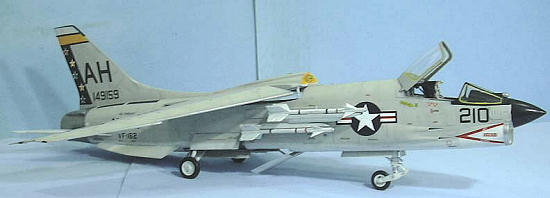 The kit provides decals for two
aircraft: the CAG for USS Oriskany from
VF-162 in 1968, and the CAG for USS Ticonderoga, which was the original markings
provided in the 1/48 Hasegawa kit.
The kit provides decals for two
aircraft: the CAG for USS Oriskany from
VF-162 in 1968, and the CAG for USS Ticonderoga, which was the original markings
provided in the 1/48 Hasegawa kit.
The kit provides a fully-detailed
J-57, which is the same parts originally provided in the F-100, with a different
afterburner can.
As with the F-100, none of this other than the burner can will be
seen when the model is completed unless a modeler goes to town opening the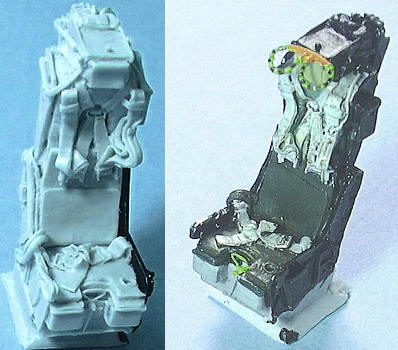 fuselage.
The kit also provides detailed gun bays for the 4 20mm cannon,
and the dive flap - which is frequently seen in the down position for airplanes
with the variable-incidence wing raised - is provided with nice detail.
On the Hasegawa 1/48 kit, one could only get this level
of detail by purchasing a fairly expensive resin aftermarket set from
Meteor/Cutting Edge.
fuselage.
The kit also provides detailed gun bays for the 4 20mm cannon,
and the dive flap - which is frequently seen in the down position for airplanes
with the variable-incidence wing raised - is provided with nice detail.
On the Hasegawa 1/48 kit, one could only get this level
of detail by purchasing a fairly expensive resin aftermarket set from
Meteor/Cutting Edge.
AMS Resins Ejection Seat:
While Black Box has released an expensive resin cockpit that doesn’t really add that much detail to the small F-8 cockpit, AMS Resins has done a really excellent Martin-Baker ejection seat, that is every bit as good as the superb seats done for the F-86 and the F-100. The seat features full harness detail, molded in ways I don’t see how a resin mold can be made. The seat sells for $12 from AMS resins and is highly recommended as the crowning touch for a really nice model from this kit.
| CONSTRUCTION |
I began construction with the wing
for a change.
I assembled the main structure with the outer wing panels
unfolded, then assembled the slats and flaps.
I then went ahead and assembled the fuselage.
I had decided not to open up the
fuselage, so I glued the gun bay doors and the airstart turbine compressor
access door closed, doing this on each fuselage half before further assembly and
gluing the panels from inside.
Doing it this way insured good fit of the parts and that
I wouldn’t get any excess Tenax on the outer surfaces.
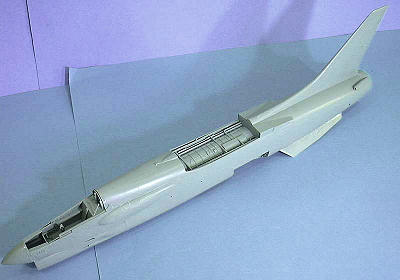 Assembly is very similar to that of
the 1/48 Hasegawa kit, which pretty obviously served as a model for this model.
I don’t say that as a complaint, since the Hasegawa kit
is easily the best F-8 Crusader kit other than this one.
Assembly is very similar to that of
the 1/48 Hasegawa kit, which pretty obviously served as a model for this model.
I don’t say that as a complaint, since the Hasegawa kit
is easily the best F-8 Crusader kit other than this one.
Once the fuselage was assembled, I
set about test-fitting the slats and flaps to the wing, and test-fitting that
with the fuselage.
I had discovered with the Hasegawa kit that there is a
lot of “fiddling” to be done to get proper fit and clearance if one wishes to do
the model with the wing raised.
As with the Hasegawa kit, I had to
trim the inner surface of the flaps so there was clearance with the fuselage
when the wing was attached.
I also discovered that it would have been a better idea
not to have assembled the slats first before attaching them to the wing.
This is because when you do it the way I did it, you end
up with the rear of the slat being raised higher than the wing surface; the part
is really made (as it was on the Hasegawa kit) to be in the raised position.
If I was doing this over, I would glue the upper
surfaces of the slats to the completed wing structure, then I would cut away the
lower parts so there was nothing going inside the front of the wing.
This way you can get the proper look, and no one will
notice the surgery on the lower surfaces.
This is a trick I learned lowering the flaps on the old
Monogram kit.
You will also have to carve away the inner surface of the inner
slat so that it can be lowered properly without ending up improperly fitted and
creating a gap along the inner surface.
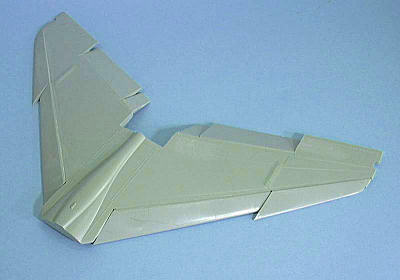 I also used
some Evergreen rod to fill the holes on the lower wing surface since I was not
using the bomb racks for this model.
I also used
some Evergreen rod to fill the holes on the lower wing surface since I was not
using the bomb racks for this model.
Other than the “some modeling skill
required” effort with the wing, the assembly of the kit presented no other
difficulties.
I left the fuselage and wing as separate sub-assemblies, with the
elevators left off, for painting.
I used the four Sidewinders left
over from the F-100, since this kit only provides two Sidewinders, though it
provides the four-missile rail mount, which it provides Zuni
packs for.
You should be aware that not all
Crusaders had the Rear Warning Radar (RWR) pod on the vertical fin.
This did not come into widespread use until 1967.
I had a photo of the airplane I intended to do, which
clearly showed it did not have the RWR fairing, so I left it off.
Whenever possible, a modeler should get a photo of the
Crusader they are doing to check this.
| COLORS & MARKINGS |
Painting:
I first painted the afterburner,
using Tamiya Tungsten and Flat Aluminum, going over it with Talon Dark Aluminum
and Pewter, in order to get the multi-hue look of the original. Then I painted
the leading edges of the wing and tail with Tamiya Flat Aluminum to duplicate
the Coroguard, which I masked off when dry.
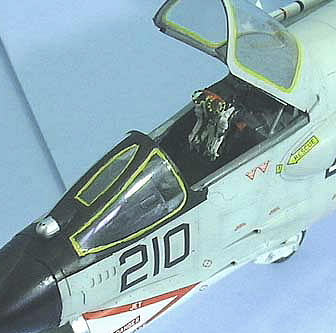 I then pre-shaded the model with
Tamiya Dark Grey, then applied the lower surface color, using Tamiya Gloss White
to which I had added a brushful of Blue-Grey to tone it down.
I also painted all the parts still on the trees for the
landing gear, dive flap and the Sidewinder rails.
The upper surfaces were painted with Xtracrylix Light
Gull Grey, to which I then added a brushful of white and went over the upper
areas to simulate tropical sun-fading.
The radome and the windscreen frame were painted with
Tamiya Semi-gloss Black.
I then pre-shaded the model with
Tamiya Dark Grey, then applied the lower surface color, using Tamiya Gloss White
to which I had added a brushful of Blue-Grey to tone it down.
I also painted all the parts still on the trees for the
landing gear, dive flap and the Sidewinder rails.
The upper surfaces were painted with Xtracrylix Light
Gull Grey, to which I then added a brushful of white and went over the upper
areas to simulate tropical sun-fading.
The radome and the windscreen frame were painted with
Tamiya Semi-gloss Black.
Decals:
I wanted to do the Crusader Dick
Bellinger was flying when he shot down the MiG-21.
The kit decals
provided a lot of the VF-162 markings, and I was able to get the proper numbers
for the serial and the squadron number from the decal dungeon.
I also had to source letters and numbers to do the BuNo
under the horizontal stabilizers, since Trumpeter doesn’t provide that decal on
their sheet.
I didn’t have to worry about the fact they also didn’t include
the blue stripe with yellow stars that goes under the nose on VF-162 Crusaders,
since that was a marking from the second Vietnam tour, and this airplane was on
the first tour.
The Trumpeter decals were much better than any I had used
earlier, with accurate national markings.
| FINAL CONSTRUCTION |
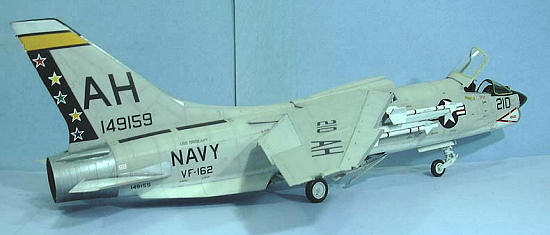 I gave the model an overall coat of
Xtracrylix Satin varnish, then applied Xtracrylix Flat varnish with a brushful
of Tamiya Flat Base for the upper surfaces.
When this was dry, I unmasked the canopy and windscreen,
and painted the yellow “caulk” by hand with a 00000 brush and Xtracrylix “RAF
Trainer Yellow.”
I also unmasked the leading edges of the flying surfaces and the
afterburner.
I gave the model an overall coat of
Xtracrylix Satin varnish, then applied Xtracrylix Flat varnish with a brushful
of Tamiya Flat Base for the upper surfaces.
When this was dry, I unmasked the canopy and windscreen,
and painted the yellow “caulk” by hand with a 00000 brush and Xtracrylix “RAF
Trainer Yellow.”
I also unmasked the leading edges of the flying surfaces and the
afterburner.
I then assembled the landing gears and attached them to the fuselage, then attached the wing, and finally attached the horizontal stabilizers in the down position they were usually left in when the Crusader was shut down and parked. I finished off by attaching the missile rails and the Sidewinders, and attaching the canopy in the open position after fitting the AMS seat in the cockpit.
| CONCLUSIONS |
This Crusader kit is equally as
good as the 1/48 Hasegawa kit and can be recommended unhesitatingly.
It is an easy model to build unless you intend to droop
the slats and flaps, in which case you need to do some surgery to get proper
fit, but none of this is particularly difficult.
The end result is a very good looking model of a very
interesting airplane.
I do note that Zotz decals is releasing two aftermarket
decal sheets of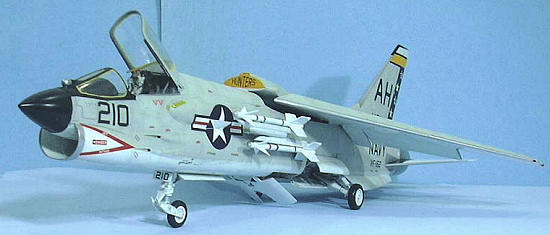 the F-8J, which is the rebuilt F-8E, so there are some aftermarket decals that
will soon be available.
Highly recommended for those fans of US Navy fighters.
the F-8J, which is the rebuilt F-8E, so there are some aftermarket decals that
will soon be available.
Highly recommended for those fans of US Navy fighters.
Thanks to Stevens International for the review copy.
Tom Cleaver
February 2009
Copyright ModelingMadness.com. All rights reserved. No reproduction in part or in whole without express permission.
If you would like your product reviewed fairly and quickly, please contact the editor or see other details in the Note to Contributors.
Back to the Review Index Page 2021